Gabriele Münter and the avant-garde
The artist’s personal and professional circle through her works

This parallel tour of the Gabriele Münter exhibition takes you through a selection of her works portraying members of her closest circle. They were friends and colleagues – nearly all of them artists and largely women – who belonged to the avant-garde groups in which she was involved throughout her life.
Some of her paintings show how her life and work were linked to foremost members of the European avant-garde, from Wassily Kandinsky to Arthur Segal. Other compositions, however, depict people who, although important at the time, are virtually unknown today.
A few of the artists featured in Münter’s works are represented in the collections of the Museo Nacional Thyssen-Bornemisza. We encourage you to revisit them to complement your exhibition experience.
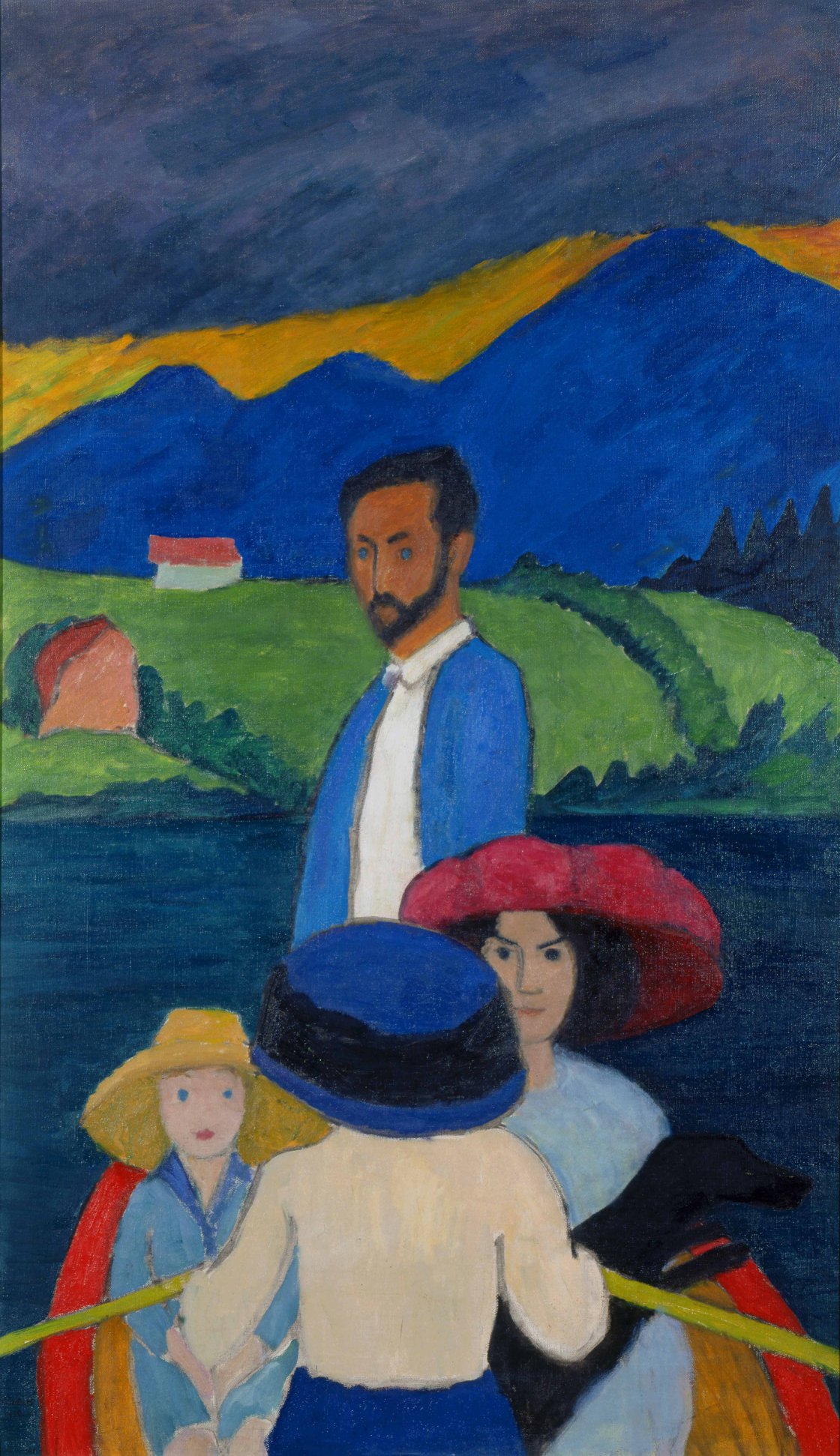
Wassily Kandinsky
(Moscow, 1866–Neuilly-sur-Seine, 1944)
Wassily Kandinsky dominates this composition, accompanied by Marianne von Werefkin in a pink hat and Gabriele Münter with her back to the viewer. The Russian painter met Münter in 1902 when he was her teacher at the Phalanx school, and they were partners in art and life from 1903 to 1916.
Their stay in Murnau in the summer of 1908, together with Werefkin and Jawlensky – who does not appear in the scene but is represented by his son Andreas – is regarded as a key event in the development of Expressionism and as the precedent for the founding in January 1909 of the New Munich Artists’ Association, known by its German acronym NKVM, of which Kandinsky was the first president. This piece, which Münter showed at the association’s second exhibition in September 1910, captures a moment during the spells the group spent working in this Bavarian village.
Wassily Kandinsky is one of the best-represented artists in the collections of the Museo Nacional Thyssen-Bornemisza. Follow this link to find out more about this pioneer of abstraction who played a key role in the development of 20th-century art, and his works in the museum.
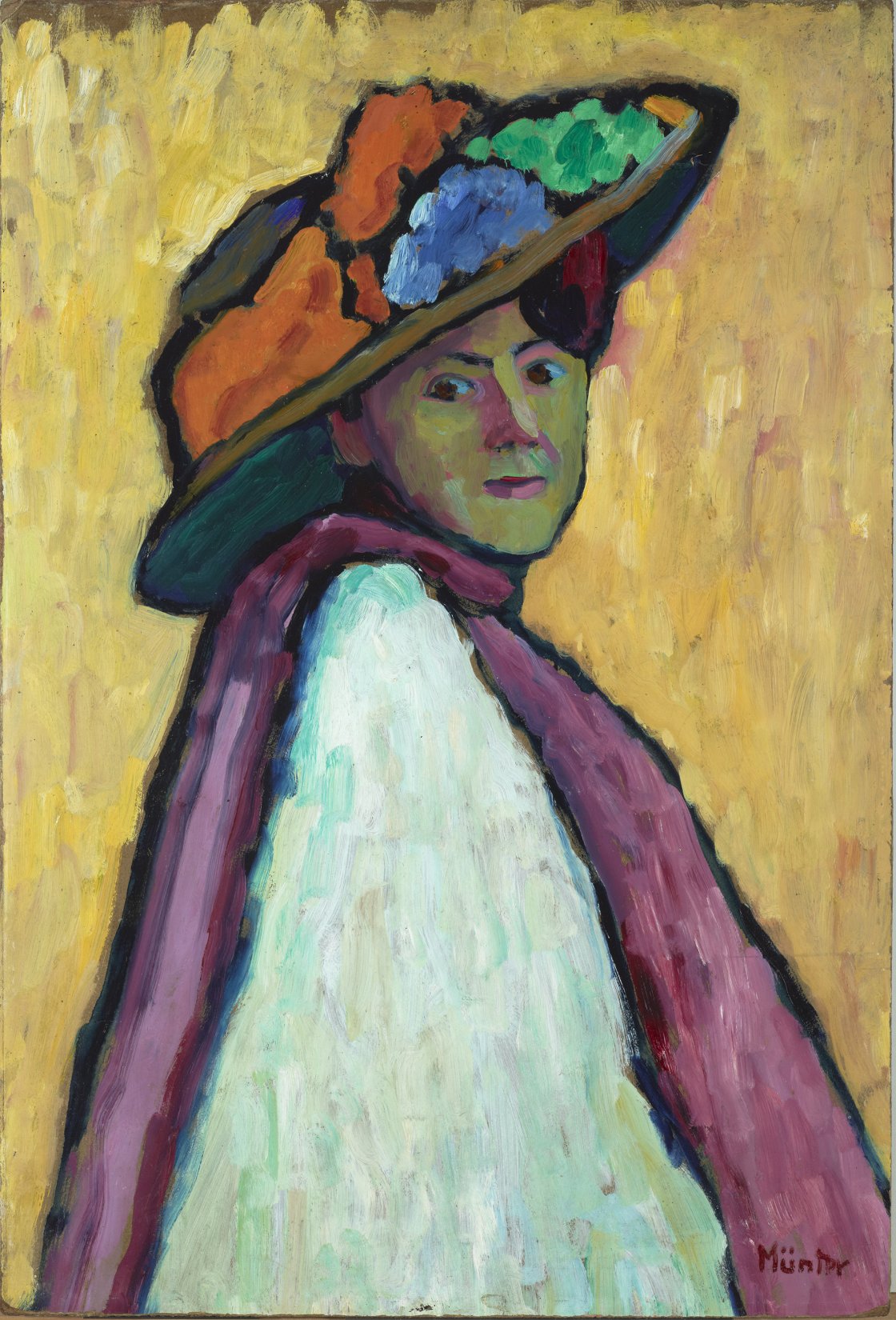
Marianne von Werefkin
(Tula, 1860–Ascona, 1938)
Marianne von Werefkin was an Expressionist painter of Russian descent who trained in the circle of the realist painter Ilya Repin (1844–1930), through whom she met fellow painter Alexej von Jawlensky, who became her romantic and artistic partner. In 1896 the couple moved to Munich, settling in the bohemian district of Schwabing.
The regular gatherings held by Werefkin in their Munich home became the epicentre of the city’s artistic renewal and spurred the progression of the Expressionist movement. They were attended by Gabriele Münter and Wassily Kandinsky, among many others.
The Russian artist, who mastered Expressionist devices before Jawlensky, Münter or Kandinsky did thanks to her profound knowledge of French art, also developed her own artistic theories and was a pioneer in anticipating abstraction. However, her writings remain virtually unknown, largely because they were not published until 1960.

Olga von Hartmann
(St Petersburg, 1885–Santa Fe, 1979)
Olga von Hartmann was married to the composer and pianist Thomas von Hartmann (1885–1956) and became involved with her husband’s personal and professional circle and activities. One of the couple’s friends was the composer Sergey Taneyev (1856–1915), who encouraged her to take singing lessons in Naples. This marked the start of a successful career as an opera singer that led her to perform in major Russian theatres.
At the turn of the century the Von Hartmanns moved to Munich and frequented the artists’ gatherings held in Marianne von Werefkin’s sitting room. There they met Wassily Kandinsky, with whom they became friends and embarked on an intense artistic and professional collaboration. As a result, Olga von Hartmann and Gabriele Münter came into contact with each other and started up a close and long-lasting relationship.
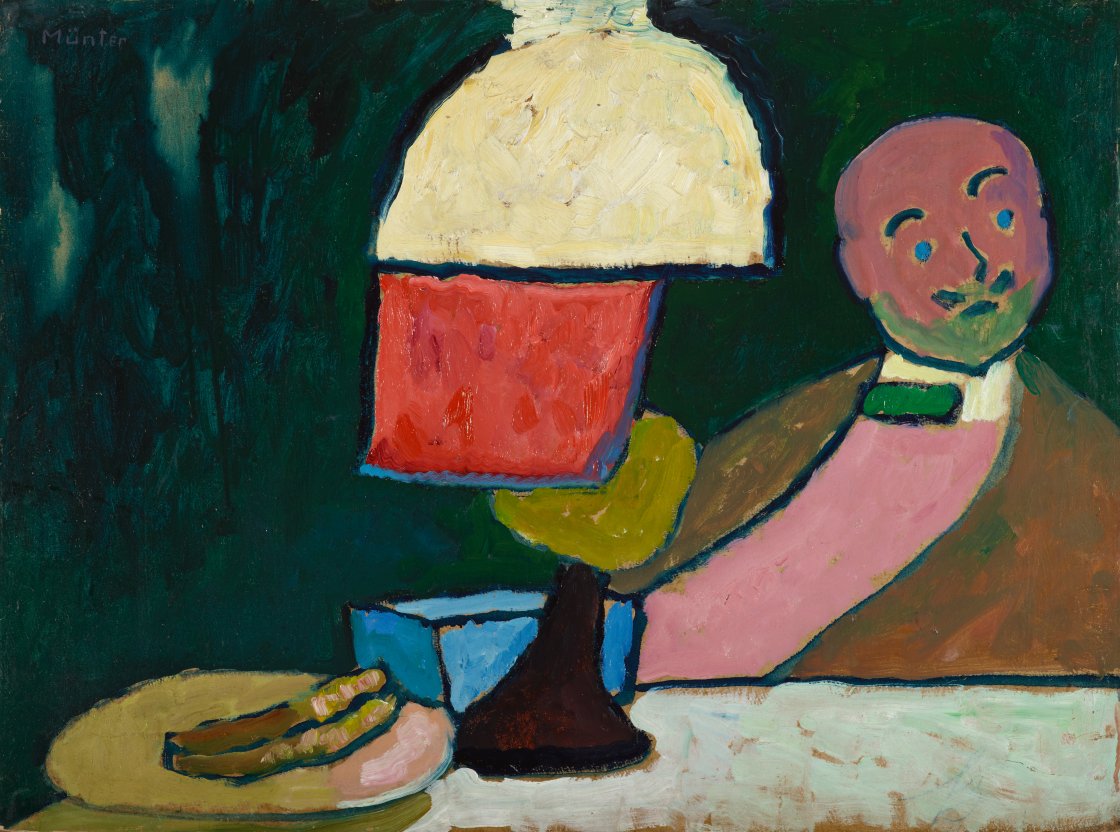
Alexej von Jawlensky
(Torzhoc, 1864–Wiesbaden, 1941)
Jawlensky, a Russian-born painter, moved to Munich in 1896. At Anton Ažbe’s painting school the following year he met Wassily Kandinsky, with whom he struck up a close friendship and a fruitful working relationship. From 1908 onwards they and their partners, Marianne von Werefkin and Gabriele Münter, formed a group of artists who developed some of the most revolutionary renewal initiatives that defined German and European art at the turn of the century. Together they founded the New Munich Artists’ Association (NKVM) in 1909 and laid the foundations of the Expressionist style in southern Germany.
Münter and Jawlensky had a special rapport, both personally and as artists. During the summers they spent in Murnau, accompanied by Werefkin and Kandinsky, they often painted together. Münter acknowledged the decisive influence of the Russian painter on her own evolution towards more simplified forms and the use of pronounced, dark contours as the result of a process of synthesis.
Follow this link to learn more about Jawlensky and his painting Red Veil, 1912.
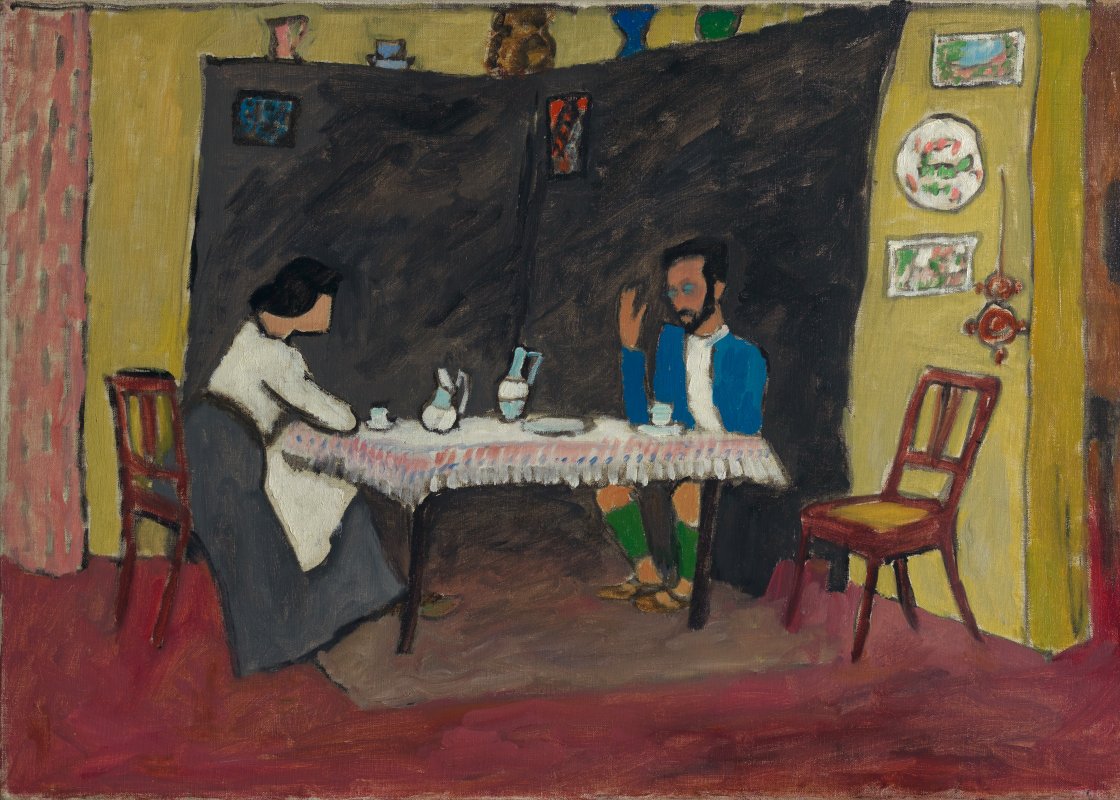
Erma Bossi
(Pola, 1875–Cesano Boscone, 1952)
Erma Bossi was an outstanding European avant-garde artist of the early 1900s. She arrived in Munich after the turn of the century to train as a painter at the Women’s Academy, where she probably met Gabriele Münter. In 1909 she co-founded the New Munich Artists’ Association (NKVM) and took part in its exhibitions. During the years leading up to the First World War, Bossi was a frequent visitor to Münter and Kandinsky’s house in Murnau, as can be seen in this canvas. She also regularly attended the gatherings at Marianne von Werefkin’s home in Schwabing.
Following the outbreak of the Great War, Bossi moved to Paris and later to Milan, where she became involved in the local artistic circles. Although she was one of the few women whose work was exhibited at the Venice Biennales of 1930 and 1935, the striking shortage of documentation on this last stage of her life and oeuvre negatively influenced her critical fortunes and led to her being left out of historians’ accounts. Major initiatives have been undertaken in recent years to revive and boost appreciation of this great artist.
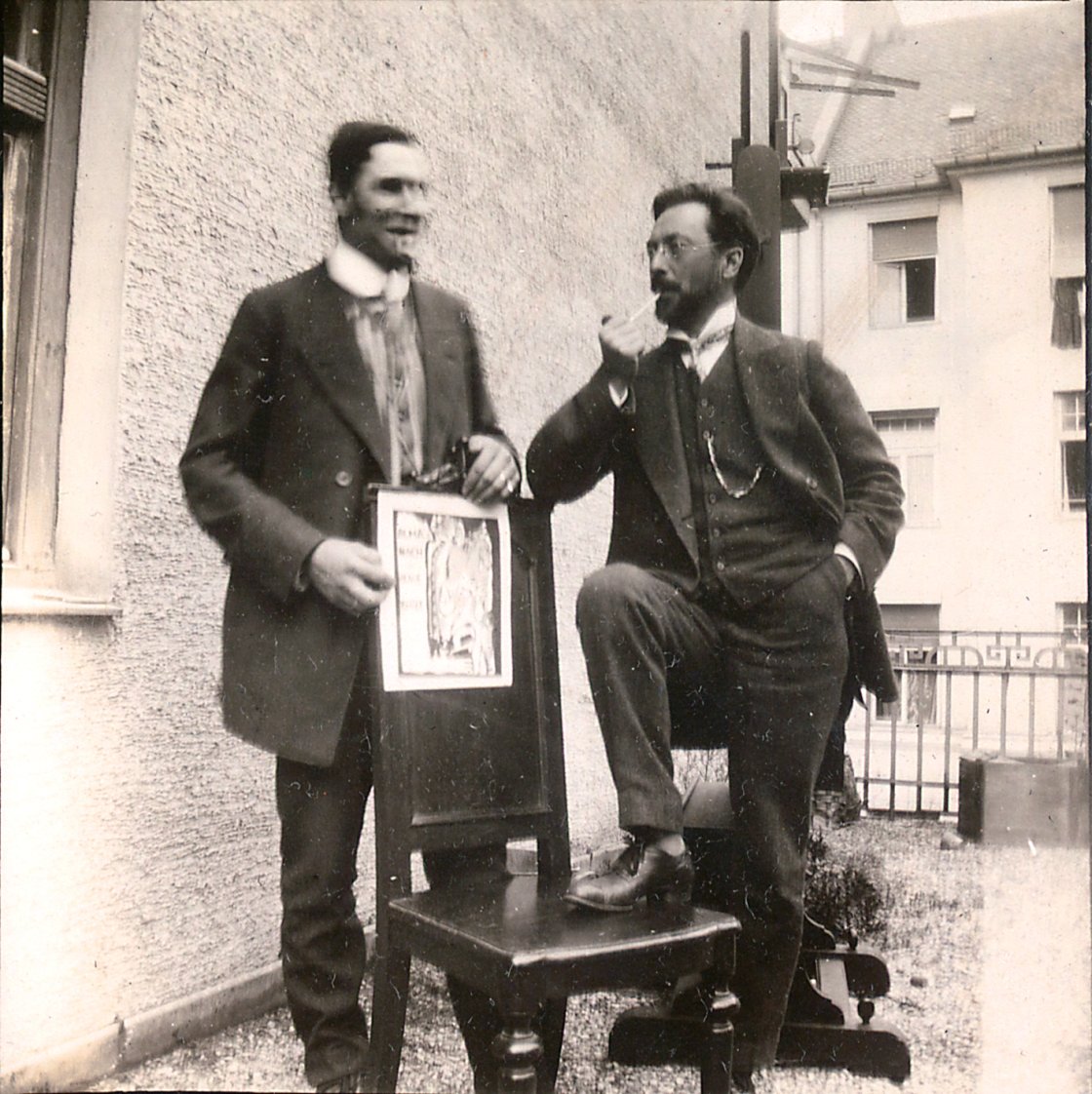
Franz Marc
(Munich, 1880–Verdun, 1916)
Franz Marc, on the left in the photograph, was one of the foremost practitioners of German Expressionism and a co-founder of The Blue Rider. In Munich he frequented the gatherings at Marianne von Werefkin’s home, where he met Wassily Kandinsky and Gabriele Münter in January 1911.
His intellectual connection with Kandinsky, who appears beside him in the photo, spurred them to work together, along with Münter, on an almanac intended as a manifesto of a new art as a form of spiritual expression. Entitled The Blue Rider, it sought the exclusive collaboration of artists and advocated all expressions of art, without classification by time, period or place. Here Marc proudly shows the cover of the first and only issue, which came out in May 1912 – not long after the photo was taken – and consolidated the establishment of one of the most important artistic groups of the 20th century.
Follow this link to learn more about Franz Marc and The dream, 1912, one of his most iconic works.
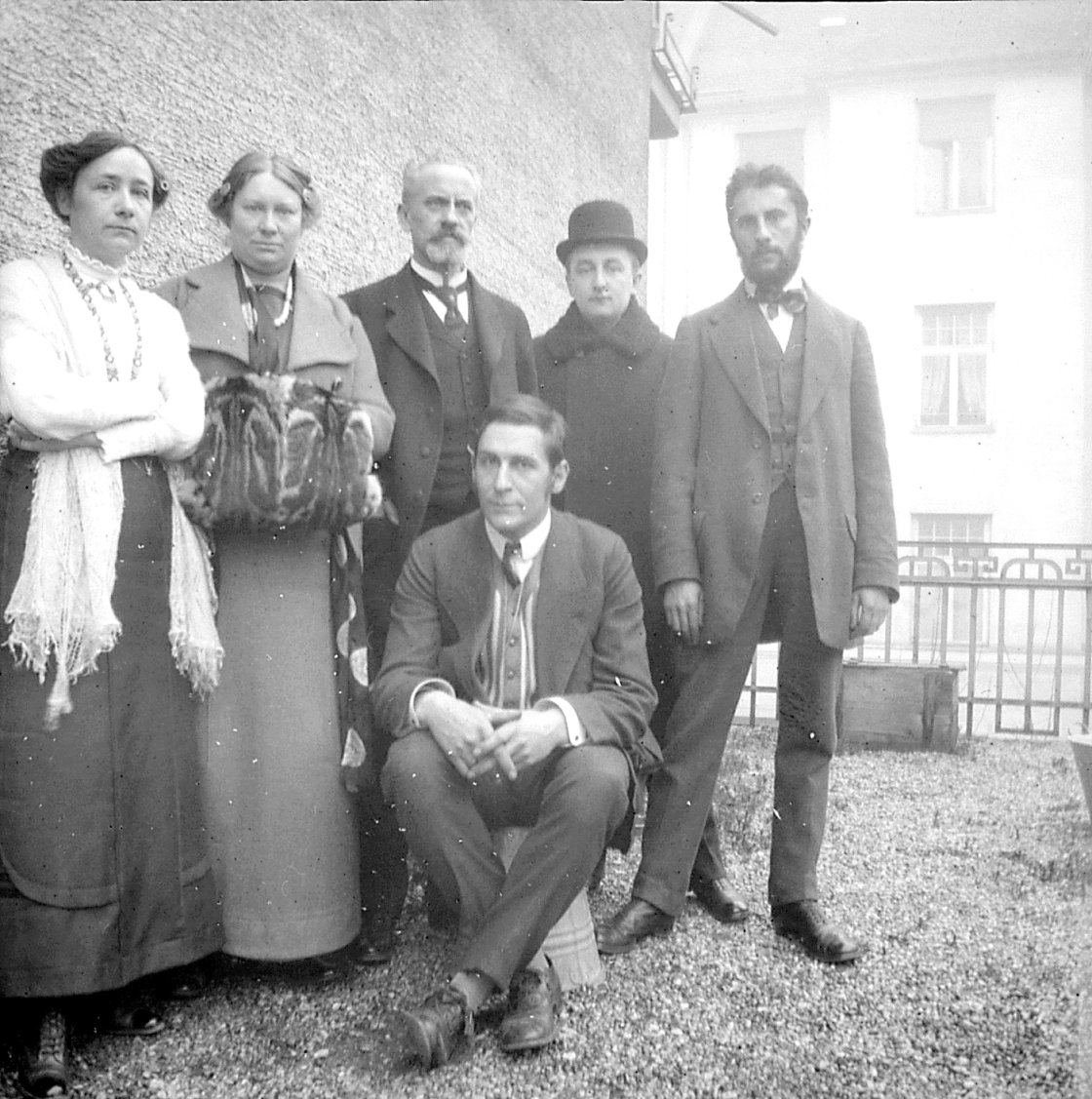
The Blue Rider
The first exhibition of The Blue Rider, the legendary group of Expressionist artists that sprang up around the publishing project headed by Wassily Kandinsky and Franz Marc and in which Gabriele Münter played a very active part, opened at the Thannhauser gallery in Munich on 18 December 1911.
Kandinsky took this photo of Münter with other members of the group. From left to right, they are:
- Gabriele Münter.
- Maria Marc (1876–1955), wife of Franz Marc. Today she is recognised as part of the influential female Blue Rider artists whose contributions to the group were as decisive as those of their male colleagues.
- Bernhard Koehler (1849–1927), a promoter and patron of the group and a relative of August Macke.
- Thomas von Hartmann (1885–1956), a Russian composer and musician very close to Kandinsky.
- Heinrich Campendonk (1889–1957), an Expressionist painter who was associated with the group through August Macke (1887–1914), another decisive figure in The Blue Rider.
- Franz Marc (1880-1916), who is seated at the front. He was one of the foremost practitioners of German Expressionism.
A visit to the permanent collections of the Museo Nacional Thyssen-Bornemisza provides a deeper insight into the work of Franz Marc and Heinrich Campendonk, as well as that of other members of the group, such as August Macke and Paul Klee, who do not appear in the photograph.
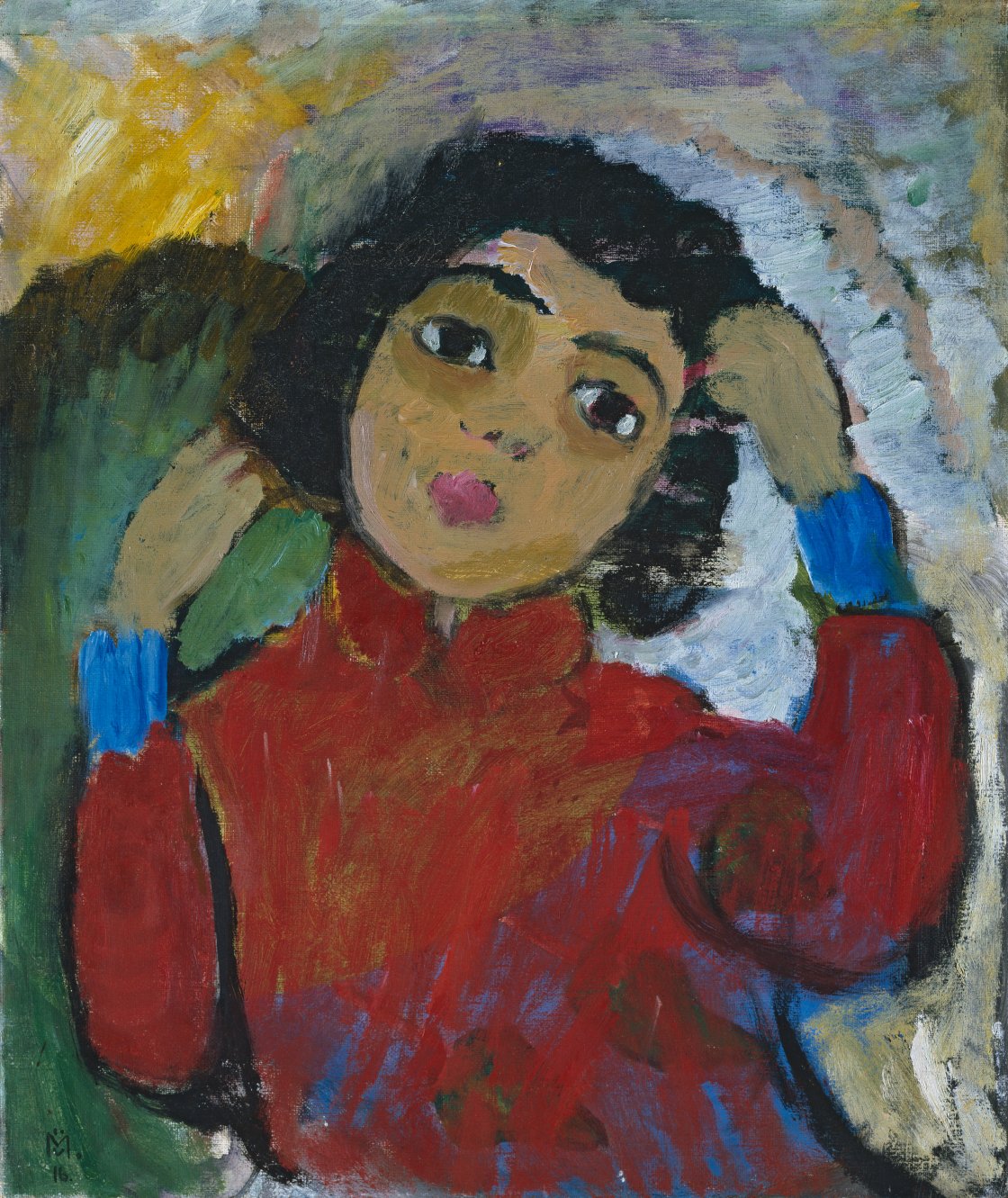
The Swedish avant-garde
Iwan, the boy portrayed here, was the only child of the Swedish artists Sigrid Hjertén (1885–1948) and Isaac Grünewald (1889–1946). They had both trained at the Matisse Academy in Paris and, after returning to Sweden, acted as a centre for the dissemination of modern art in Sweden.
Münter met the couple during her exile in Stockholm and became close friends with them. An important artistic exchange developed between the three of them and together they took part in various exhibitions promoted by the Der Sturm gallery in Berlin.
Hjertén worked as a textile designer before turning to painting. Grünewald, for his part, achieved great success decorating and designing stage sets for important buildings such as the Royal Opera House and the Stockholm Concert Hall. Also a teacher, he opened his own art school.
Anna Roslund
(Karlskrona, 1891–Copenhagen, 1945)
A writer and musician, Anna Roslund was a cultured, independent woman whom Münter portrayed in 1917 smoking and sporting a masculine garçon haircut. These elements symbolised the freedom achieved at the time by certain female members of the intellectual elite. Roslund was the sister of the artist Nell Walden (1887–1975), who, as the wife of Herwarth Walden (1879–1941), was actively involved in the activities of Der Sturm.
Der Sturm was the name of a periodical and later an art gallery. It was founded by Herwarth Walden in Berlin in 1910 and played a key role in promoting and disseminating modern art. It was also instrumental in Gabriele Münter’s artistic and professional development, not only in Germany but also during her Scandinavian exile. The professional and personal contacts provided by the Waldens in Sweden and Denmark proved essential to her livelihood. One was Anna Roslund, with whom the artist stayed for two weeks on arriving in Copenhagen in 1917.
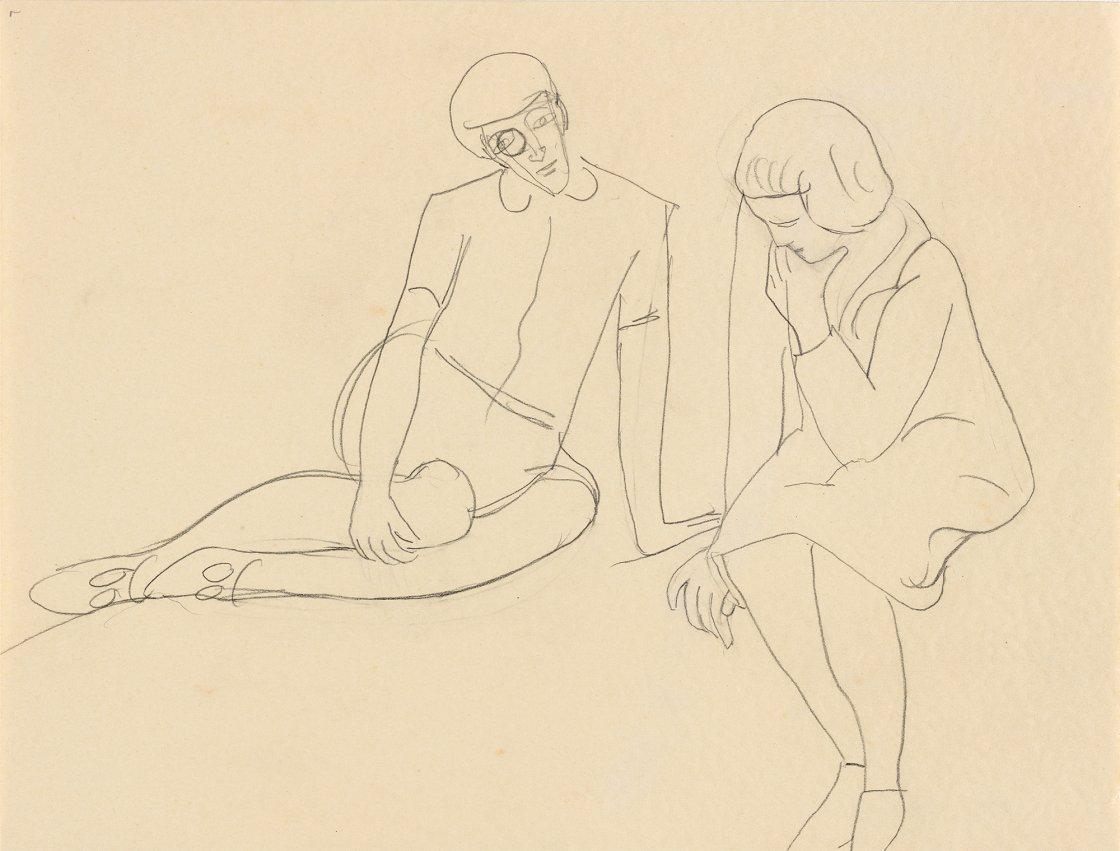
Sylvia von Harden
(Hamburgo, 1894–Croxley Green, 1963)
The focal point of Berlin’s vibrant cultural scene of the 1920s was the iconic Romanisches Café, which became a famous meeting place for intellectuals and artists during that decade.
Among the celebrities who frequented this place was the journalist and poet Sylvia von Harden, whom Gabriele Münter met in 1928. In the drawing On the Sofa, the painter places Von Harden on the left of the composition and successfully captures her essence through her carefree pose and unconventional, androgynous appearance. With her characteristic garçon haircut, the writer personified the new model of the ‘modern women’ that Münter depicted so often during those years: emancipated, independent women who frequented traditionally male intellectual circles. These traits also fascinated the artist Otto Dix (1891–1969), whose famous portrait of the journalist (Centre Pompidou, Paris) established her as an icon of modernity.
Otto Dix is represented in the Thyssen-Bornemisza collections by Hugo Erfurth with Dog, 1926.
![Gabriele Münter, The Poet E.K. [Eleonora Kalkowska] Reading, ca. 1926-1927 Gabriele Münter, The Poet E.K. [Eleonora Kalkowska] Reading, ca. 1926-1927](/sites/default/files/styles/extra_large/public/imagen/2024-07/La_poeta_E.K.jpg)
Eleonora Kalkowska
(Warsaw, 1883–Berne, 1937)
The Polish-German poet and actor Eleonora Kalkowska was a leading figure on the artistic and cultural scene in Weimar Republic Berlin and, as such, was a regular at the gatherings of intellectuals at the iconic Romanisches Café. It was there that Münter and Kalkowska met in 1926.
In the early 1900s Kalkowska had dropped out of university in Paris to devote herself entirely to writing, publishing her first famous prose work, Hunger of Life, in 1904. During the following years she combined this activity with her acting studies, and this prompted her to move to Berlin, where she performed in several theatres. The publication of her second volume of poetry, The Smoke of Sacrifice, in 1916 earned her a lasting reputation. She also wrote interesting plays. Her criticism and advocacy and her commitment to social, anti-war and feminist causes define her literary corpus and make her a living image of her time.

Arthur Segal
(Iasy, 1875–London, 1944)
Arthur Segal was a Romanian-born artist known for his ‘prismatic painting’, a formula derived from his theories on perception and compositional balance. He pursued his artistic career in Munich and Berlin and was linked to the Expressionist circles of the German capital. During the war he emigrated to Switzerland, where he came into contact with Dadaist trends. After returning to Berlin, he opened a famous painting school in 1920, at which point he recommenced his relationship with the city’s Expressionist groups.
From 1926 to 1929 Gabriele Münter attended Arthur Segal’s school, which had become a popular meeting place for the artistic avant-garde. The fact that she resumed her training at a time of both personal and professional maturity is very striking. Despite having been a pupil of his, Münter was never stylistically close to Segal; in fact, their close friendship enabled the artist to use the school as a studio for a few years when she had no fixed abode or working space of her own.
Arthur Segal is represented in the Carmen Thyssen Collection by Still Life with Candle Holder and Box, 1925-1926.
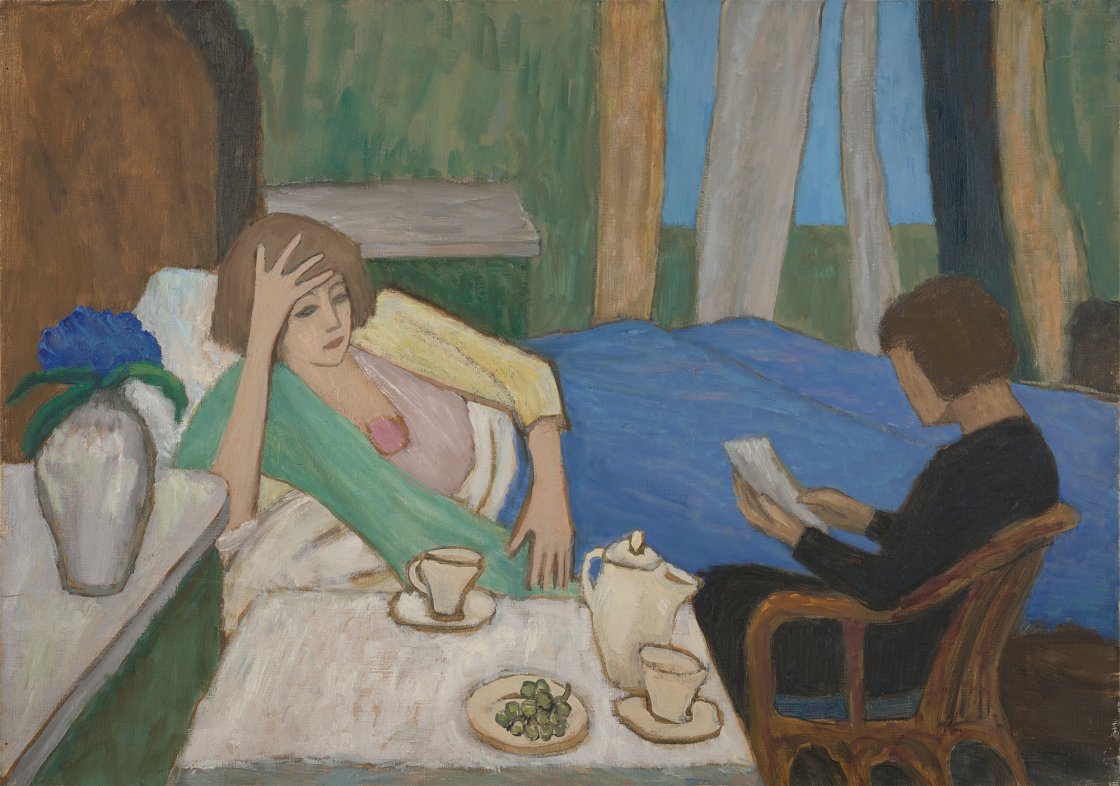
Lou Albert-Lasard
(Metz, 1885–Paris, 1969)
Lou Albert-Lasard, who is recognisable lying on the bed, was an Expressionist painter. She was always very close to the avant-garde groups active in the various cities where she lived. Around 1919 she moved to Berlin, where years later she met Gabriele Münter, with whom she also coincided at Arthur Segal’s school. Their friendship grew stronger in Paris, where they both settled in the late 1920s.
Münter and Albert-Lasard enjoyed a degree of freedom that was unusual for women of their time and shared an interest in travel which, in Albert-Lasard’s case, led her to visit various European cities, North Africa, India and Tibet throughout her lifetime. In 1940 she was arrested and interned in the concentration camp at Gurs, though this did not prevent her from continuing to draw and produce watercolours that bear significant witness to these places today.
